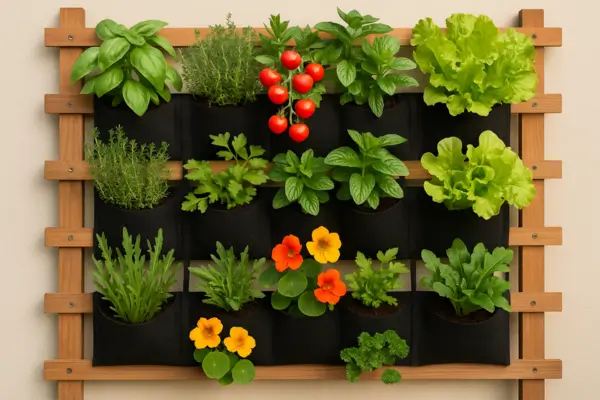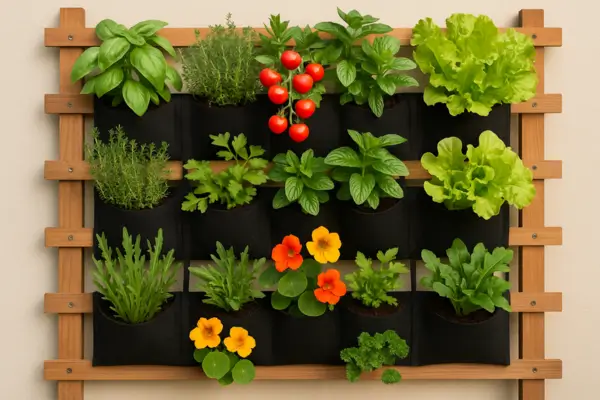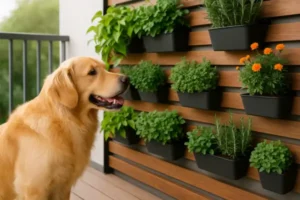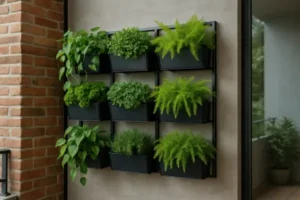Best edible plants for gourmet vertical gardens are a great way to bring more flavor to your daily meals. You don’t need a big yard or complicated tools—just a small space and a few good choices.
Growing your own herbs and greens can make cooking more enjoyable. You see them every day, you use them fresh, and it all starts to feel natural and easy.
We share simple ideas on what to grow, how each plant fits into a vertical garden, and why they can make a difference in your kitchen. Whether it’s for a salad, a cup of tea, or a quick dish, having fresh ingredients on hand always helps.
Best Edible Plants for Gourmet Vertical Gardens: Simple Choices That Work
Choosing the best edible plants for gourmet vertical gardens doesn’t have to be complicated. Some plants naturally adapt to small spaces, grow well in containers, and are perfect for everyday cooking. With the right selection, you’ll always have fresh ingredients just a few steps away.
Everyday Herbs That Grow Well and Taste Better Fresh
Herbs are one of the easiest and most rewarding things to grow vertically. They don’t need much soil, respond well to trimming, and many varieties even release a pleasant scent when touched or watered.
- Basil – Needs regular sunlight and warm weather, but once settled, grows fast. You can keep it productive by cutting the top leaves first. Perfect for sauces, pesto, or fresh on top of dishes.
- Thyme – Low-growing and great for vertical pockets. It prefers dry soil and doesn’t need much water. Adds a deep flavor to roasted vegetables, stews, and even breads.
- Chives – Very adaptable and regrows quickly after cutting. You can add it fresh to eggs, dips, soups, or anything that needs a mild onion touch.
- Mint – Best planted in its own container to control spreading. Loves moisture and partial shade. Good for teas, desserts, and refreshing touches in salads or fruits.
- Oregano – Stronger flavor when grown in full sun. Great with grilled meats, potatoes, or tomato-based recipes. You can harvest it leaf by leaf or cut stems as needed.

These herbs don’t require deep pots—just good drainage and consistent watering. A vertical wall of herbs near your kitchen or balcony door makes it easy to harvest what you need, when you need it, without waste.
Leafy Greens That Keep Producing
Leafy greens are another smart choice. They grow quickly and can be picked gradually instead of all at once. That means more harvests from the same plant, and fewer trips to the store.
- Arugula – Grows fast and thrives in cooler conditions. Its peppery flavor brings life to simple salads, sandwiches, or pizzas. It prefers shallow containers and regular watering.
- Spinach – Loves a mix of sun and shade. Look for compact varieties for vertical growing. You can steam it, sauté it, or add it raw to smoothies or bowls.
- Loose-leaf Lettuce – These don’t form a head, which makes them perfect for cutting a few leaves at a time. You can grow several colors and textures together for variety on your plate.
A tip that helps: plant a few of each type every one or two weeks instead of all at once. This way, your vertical garden stays full and active throughout the season, with new growth coming in as you harvest the older leaves.
Edible Flowers and Unexpected Favorites for Gourmet Vertical Gardens
When we think about the best edible plants for gourmet vertical gardens, herbs and leafy greens are usually the first to come to mind. But there are other ingredients that also fit well into small vertical spaces—and they can make a real difference in both taste and presentation.
Some flowers are edible, with unique flavors that also add charm to your garden. And there are lesser-known plants, like small chili peppers or lemongrass, that bring a creative twist to your cooking when you want something a little different.
Edible Flowers That Look Beautiful and Taste Great
Edible flowers play a unique role in the kitchen. They’re light, decorative, and often bring a gentle, floral or slightly spicy flavor. Here are a few that grow well in vertical gardens:
- Nasturtiums – The petals have a mildly peppery taste, similar to arugula. They’re great in salads, and their bright colors make any dish more cheerful.
- Calendula (Marigold) – With bold orange tones and a subtle taste, calendula can be used in soups, rice, or homemade teas.
- Violas and Pansies – Very delicate in both texture and flavor. They’re ideal for decorating desserts, blending into teas, or topping elegant meals.
These flowers thrive in vertical pockets or shallow pots. They prefer partial to full sun and soil that stays moist without getting soggy. As a bonus, they tend to attract pollinators—helpful if you have other plants nearby.
Special Plants That Bring Extra Flavor
Beyond flowers, there are a few less conventional plants that also fit well in a vertical gourmet garden. They don’t take up much space and can add bold flavors to your dishes.
- Lemongrass – Grows in slim, grassy clumps with a strong citrus aroma. It’s perfect for teas, marinades, and Southeast Asian recipes.
- Mini Chili Peppers – Small ornamental or aromatic varieties work great in containers. They add heat, color, and character to your garden.
- Microgreens – These tiny seedlings are harvested young and grow quickly in shallow trays. They’re rich in flavor and nutrients, and ideal for topping sandwiches or salads.
These plants need a bit more attention when it comes to light and watering, but they reward you with interesting flavors and a lively garden full of color and texture.
How to Choose the Right Setup for Your Edible Garden
Setting up an edible vertical garden doesn’t have to be expensive or complicated. But choosing the right setup from the start can save you time, water, and frustration. What really matters is knowing what you want to grow — and how you’ll care for it on a regular basis.
There are several types of vertical systems, and each one is best suited to your plants and your space. There’s no one-size-fits-all — the best one is the one that fits your routine.
Common Systems That Work Well in Your Home
Here are some easy-to-use options that work well for herbs, leafy greens, and edible flowers:
Fabric pockets — Often attached to walls, these are great for herbs, microgreens, and light-weight flowers. They drain quickly, which prevents overwatering, but they also dry out more quickly.
Stackable modular planters — Ideal for balconies or patios. Each tier can accommodate different types of plants. You can easily move or rotate them, which helps with sunlight.
Individually-mounted wall planters – These give you more control over soil and watering. They’re a good option for plants with deeper roots, like mini peppers or compact varieties of chili peppers.
All of these setups work well with light soil and basic drainage. If you’re watering by hand, make sure that excess water can drain down without pooling. In some cases, placing a tray or saucer in the bottom helps keep everything organized.
Placement tips that make all the difference
Even the best setup needs the right spot to work well. Before you set anything up, take a moment to check:
Hours of sunlight – Most herbs need at least 4 hours of direct sunlight. Greens like spinach and lettuce do best with a little shade during the hottest part of the day.
Easy access for watering – Avoid areas that are hard to reach or far from a water source. The easier it is to maintain, the more consistent your harvest will be.
Comfortable height for harvesting – Place the plants you use most often at eye or waist level. This makes it easier to pick out what you need while you’re cooking or walking around.
When everything is organized in the right place, caring for your vertical garden becomes part of your daily routine—watering, pruning, and harvesting become simple and enjoyable.
Organizing by Flavor: A Simple Way to Make Your Garden More Useful
When you’re in the kitchen every day, some combinations of ingredients start to seem automatic. Basil and tomatoes. Mint and lemon. Rosemary and garlic. That’s why it makes so much sense to design your vertical garden based on what goes well together.
Most people organize their plants by size, sunlight, or watering needs. That works. But if you group your edible plants according to their use in the kitchen, your garden becomes more than convenient—it becomes intuitive.
You walk out, see the combinations, and instantly have lunch or dinner ideas. This small layout change can change the way you cook, plan meals, and even how often you use your plants.
Flavor Groupings That Make Everyday Cooking Easier
Think of your garden in zones—each one that’s compatible with a cooking style you enjoy. Here are three practical groupings that work for most kitchens:
Mediterranean Essentials
Basil, Oregano, Thyme, Cherry Tomatoes – These herbs thrive in the sun and pair naturally with pasta, pizza, flatbreads, tomato sauces, and grilled vegetables.
Bright and Cool Zone
Mint, Chives, Cilantro, Arugula – Ideal for refreshing salads, wraps, frozen drinks, salsas, and spring rolls. They’re great for summer dishes and do well in partial sun.
Bold and Flavorful Base
Rosemary, sage, pepper, spinach – Best for warm, comforting meals—roasts, soups, stews, and hearty side dishes. These plants enjoy more sun and a steady routine.
Each group can occupy a row, column, or even a panel of your vertical layout. You don’t have to follow it exactly—just close enough that everything you need is in one place when a recipe comes to mind.
The Hidden Benefits of Flavor-Based Layouts
Organizing by flavor may seem like a small detail, but it adds practical value to your daily life:
- It turns your garden into a cooking station – No need to think twice. You see a group, you pick, you cook.
- You reduce waste naturally – When plants are used together, you’re more likely to use them all instead of letting one go bad.
- It keeps your meals interesting – You get inspired just by looking at your wall. The combinations are already there.
- Maintenance becomes easier – As it happens, many flavor groupings also align with light and watering needs, simplifying care without effort.
It’s a simple trick with real impact. Instead of just planting herbs randomly, you’re creating a space that works like part of your kitchen—responsive, flavorful, and ready whenever you are.
A garden is never just something you build and forget. It’s something you live with. Especially when it’s full of edible plants, keeping it productive means learning a rhythm—how much to water, when to trim, how to help each plant keep giving without wearing out.
In a vertical setup, this balance matters even more. The soil is limited, the drainage is faster, and the plants are often packed closely together. So instead of thinking in terms of “maintenance,” think in terms of daily flow—short, regular habits that keep the whole system healthy and alive.
Harvesting as a Form of Care
Harvesting isn’t the final step—it’s part of the life cycle. Many plants produce more when you take just a little, often. But the way you harvest makes all the difference.
- Basil, mint, oregano, thyme: These herbs respond best when trimmed from the top down. Always cut above a node (a pair of small leaves) so the plant branches out instead of getting leggy.
- Leafy greens like spinach, arugula, lettuce: The outer leaves are the oldest—start there. Keep the inner core untouched, and the plant will keep producing fresh leaves for weeks.
- Microgreens: These are one-cut harvests, but you can reseed them easily every 7 to 10 days. Having two or three trays at different stages ensures a continuous supply.
- Edible flowers: Regular picking prevents the plant from diverting energy into seed production. The more you use them, the more they bloom.
If you wait too long to harvest, many of these plants will bolt—sending out flowers, getting bitter, or just slowing down. Frequent small harvests don’t just feed your kitchen—they extend the life of the plant.
Daily, Weekly, and Seasonal Habits That Support Growth
You don’t need complicated tools or systems. But you do need consistency. Here’s how to keep your vertical garden running smoothly across the days and weeks:
Daily Routine
- Check soil moisture in the early morning. Top layers may dry out faster than the lower ones, especially in fabric or shallow pockets.
- Feel the leaves. Wilting doesn’t always mean underwatering—sometimes it’s too much. If the soil feels wet, wait.
- Water slowly and deeply, at the base of each plant. This encourages roots to grow downward and strengthens the plant.
Weekly Routine
- Inspect for pests or signs of disease. Vertical gardens tend to be less prone, but enclosed spaces can trap humidity.
- Rotate containers if one side gets more light than the other. Even a small turn can help balance growth.
- Trim back any overgrowth, especially from fast spreaders like mint or oregano, so they don’t shade out other plants.
Monthly or Seasonal Adjustments
- Refresh topsoil or add compost in small amounts. Vertical gardens have limited nutrients, and herbs especially will show signs when soil gets tired.
- Switch out plants that are past their peak. If a leafy green has bolted, replace it with a new seedling or change to something better suited for the current temperature.
- Reposition planters as the sun shifts between seasons. A wall that got morning light in spring might be in full shade by late summer.
With just a little observation and intention, your vertical garden stops being something you have to manage—and becomes something that quietly supports you, every day.
Conclusion
The best edible plants for gourmet vertical gardens can quietly change your daily routine. They bring ingredients closer together, make food preparation easier, and transform even a small space into something you use with purpose.
The plants you choose matter most when they adapt to your way of cooking, eating, and living.
When you group plants by flavor and create a setup that fits your space, your garden becomes part of your daily flow. Soon, picking fresh ingredients feels effortless—and your meals start with what’s growing right next to you.




